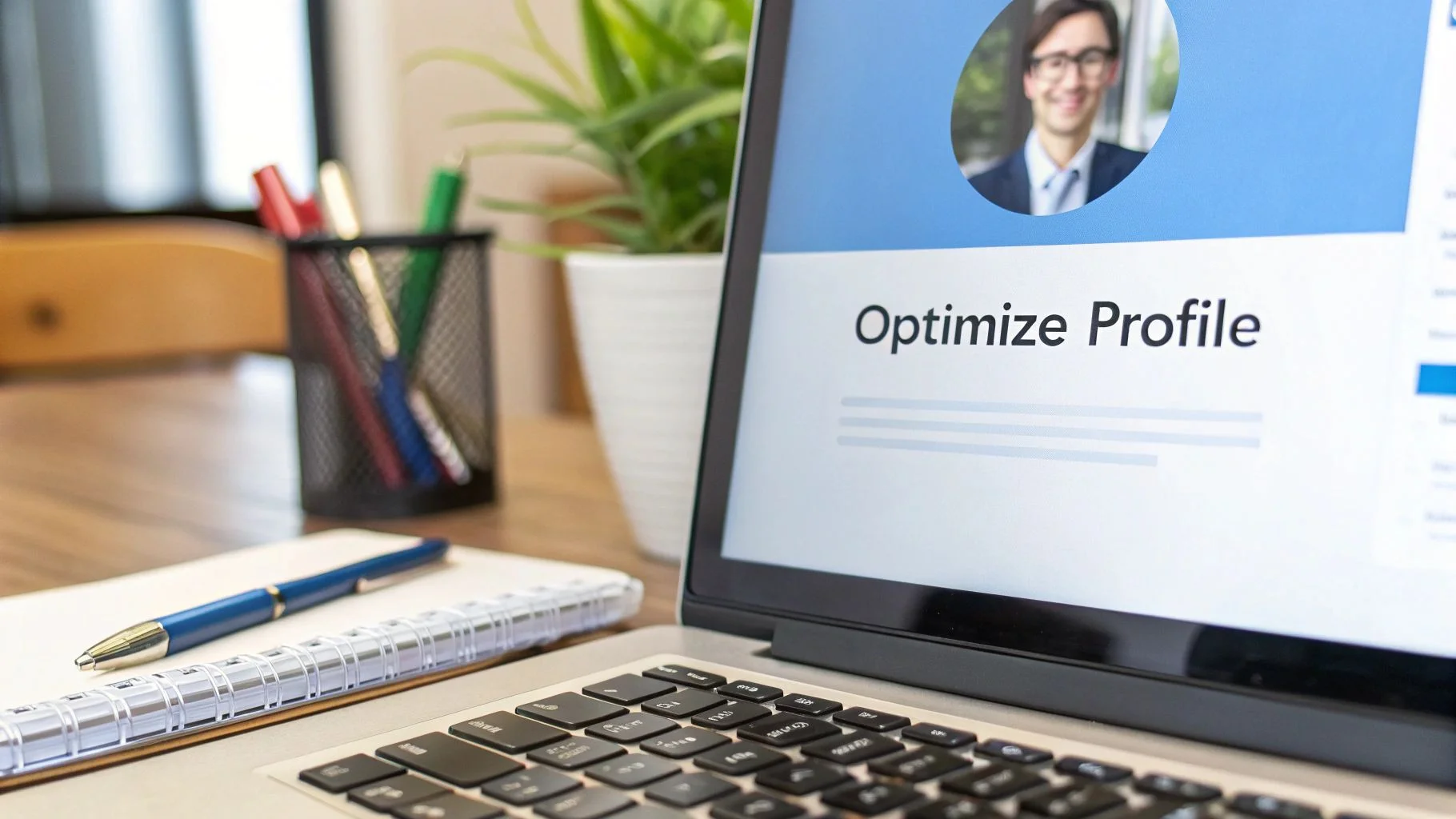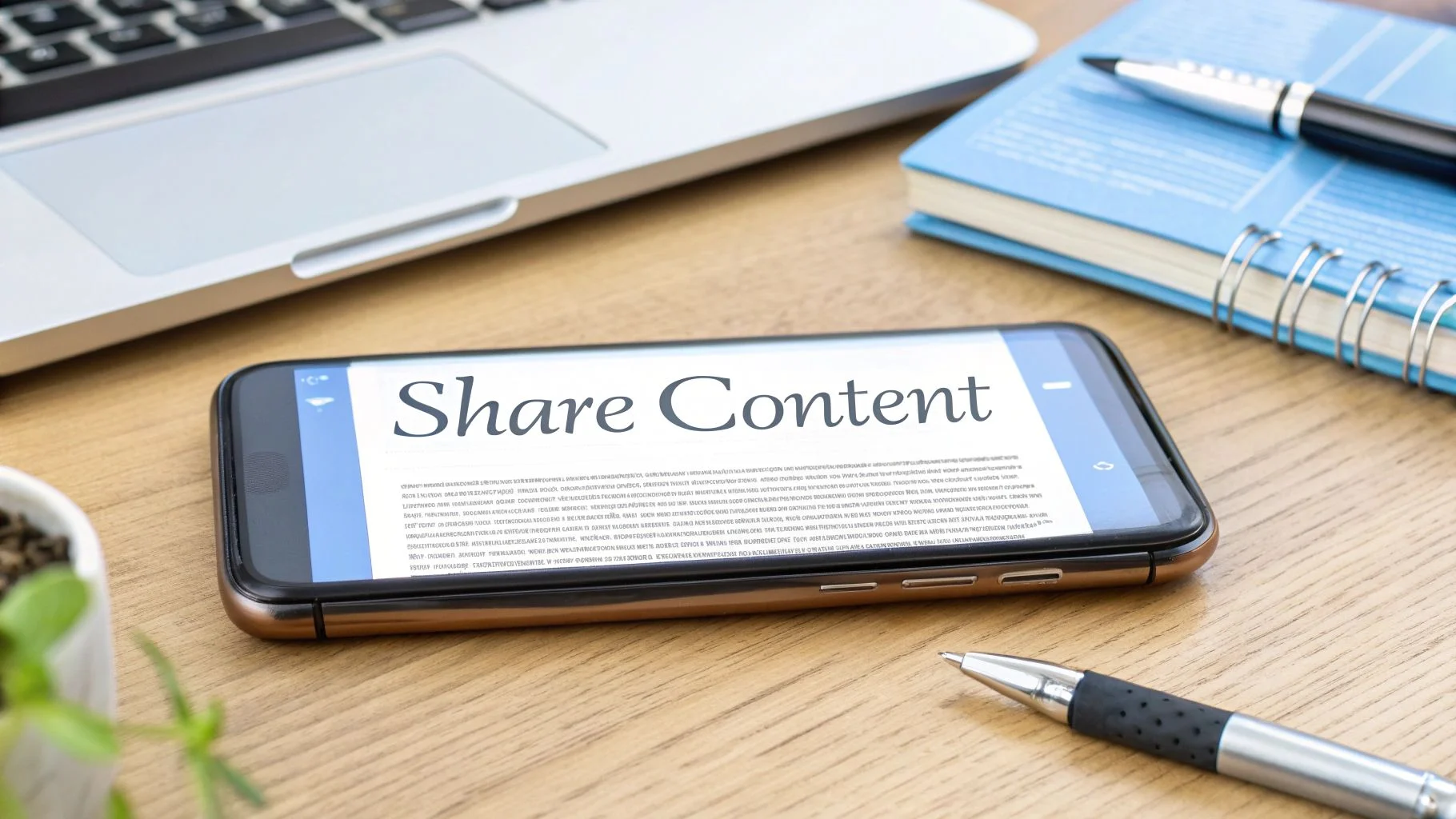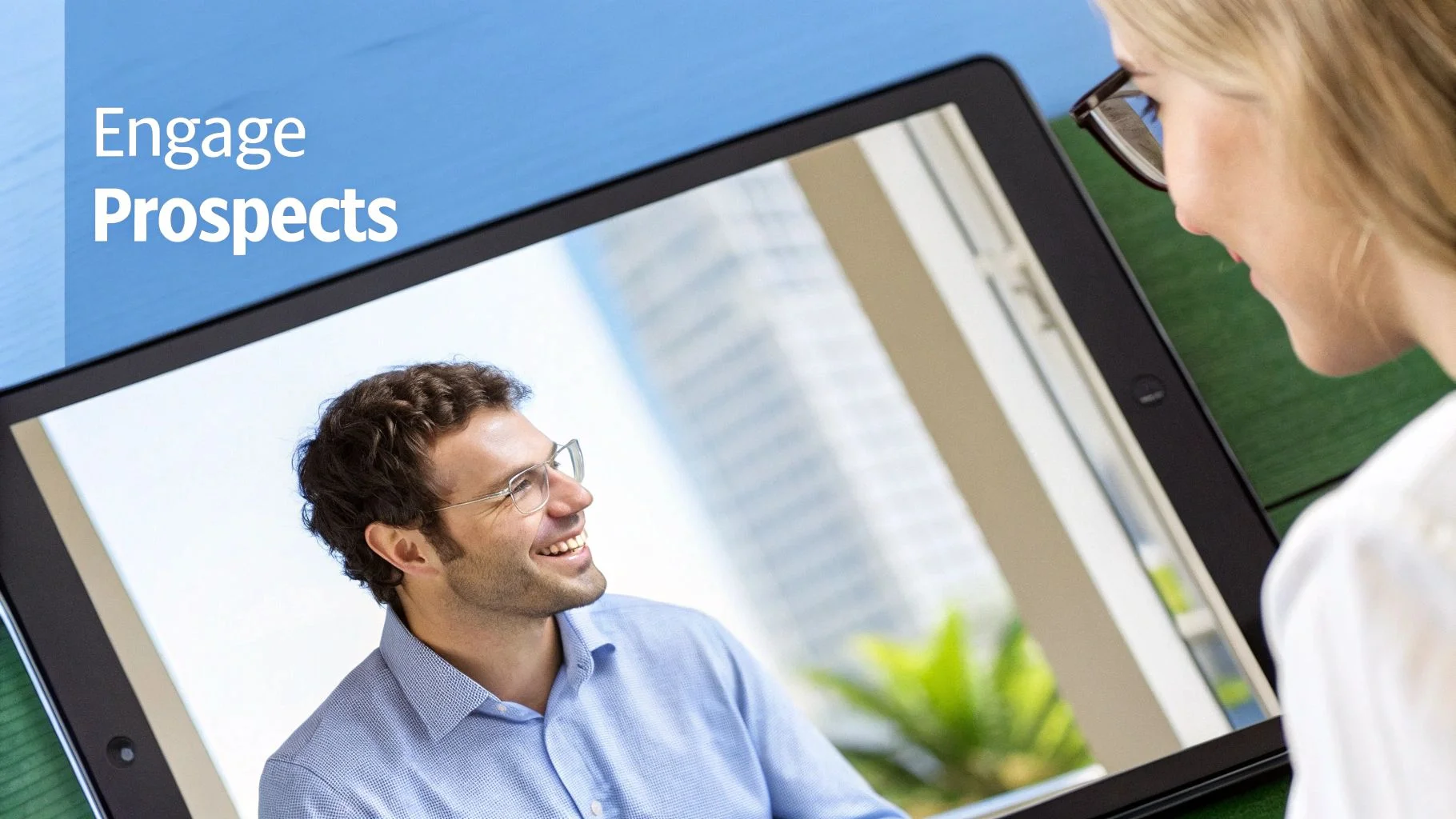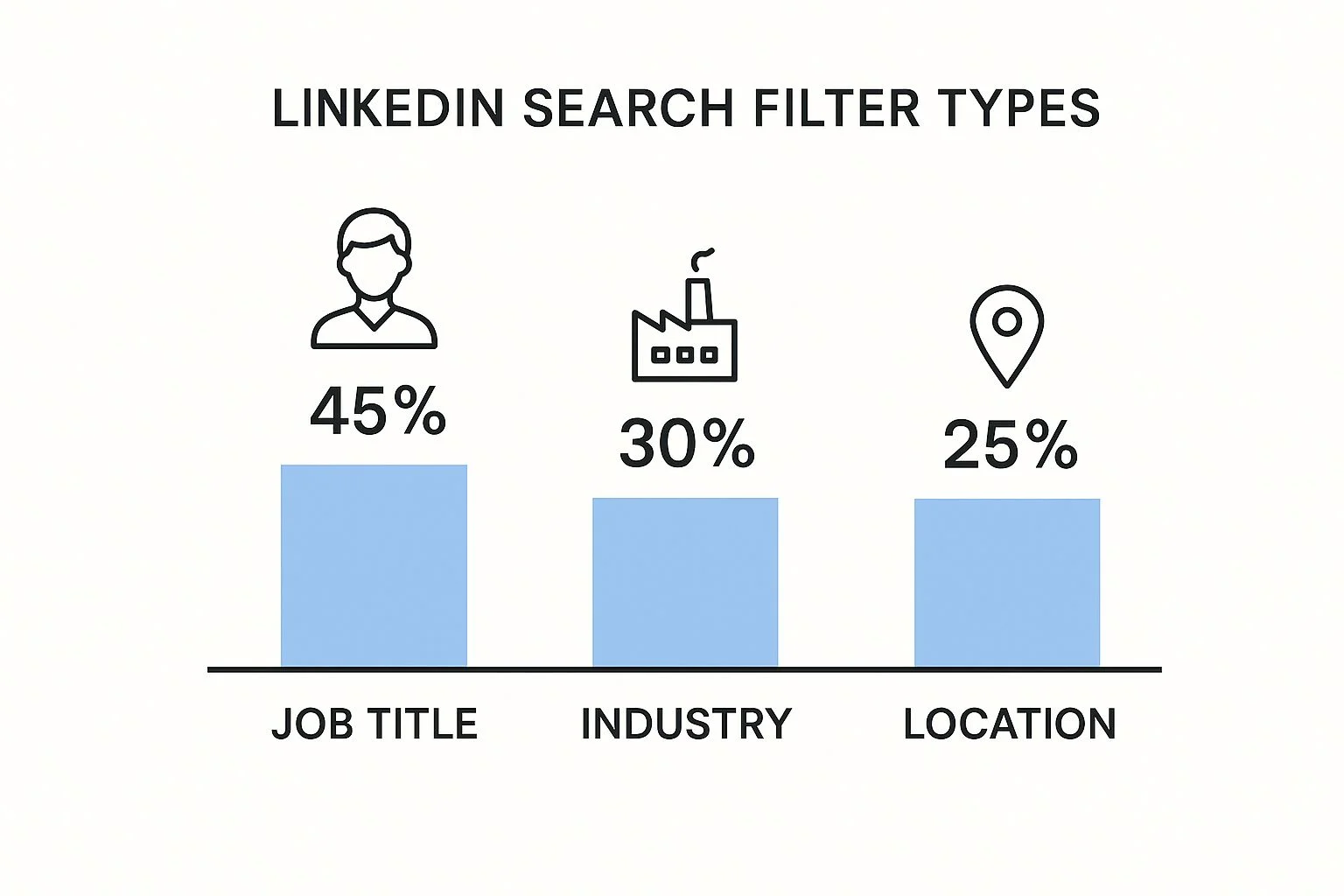How to Generate Leads on LinkedIn
Master LinkedIn lead generation with proven strategies. Turn your profile into a 24/7 automated lead magnet that attracts your ideal clients.

How to Generate Leads on LinkedIn
Generating leads on LinkedIn all starts with your profile. But not in the way you might think. It's not about listing your job history; it's about turning your personal page into a resource that speaks directly to your ideal client.
Get this right, and your profile becomes an automated lead magnet that works for you 24/7, even while you sleep.
Turn Your Profile Into a Lead Magnet

Before you even think about sending a connection request or writing a single post, your profile has to do the heavy lifting. Think of it like a digital storefront. If it’s messy, confusing, or all about you, potential clients will just scroll on by.
The goal is a simple but powerful shift: move your profile’s focus from "who I am" to "how I solve your problem."
So many people make the classic mistake of treating their LinkedIn like a CV. It’s full of past job duties and company accomplishments. That’s great if you’re looking for a job, but it does absolutely nothing to attract new business.
A profile built for lead generation talks to a specific person, builds instant rapport, and positions you as the only logical choice in your field.
Craft a Problem-Solving Headline
Your headline is the most valuable piece of real estate on your entire profile. Don't waste it with a generic job title like, "Marketing Manager at ABC Corp." That tells people what you are, not what you do for them.
Instead, reframe it to highlight the value you deliver. A much stronger headline would be something like, "I Help SaaS Startups Triple Their Demo Bookings Through Strategic Content Marketing."
See the difference? This approach immediately does three critical things:
It filters for your ideal client (SaaS startups).
It promises a tangible, desirable result (triple demo bookings).
It hints at your method (strategic content marketing).
That one change takes you from a commodity to a specific problem-solver, which is magnetic to prospects actively looking for a solution.
Of course, optimizing your profile is just one piece of the puzzle. It works best when you're also actively growing your network. For more on that, check out our complete guide to increasing LinkedIn connections.
Tell a Compelling Story in Your Summary
Your "About" section is your chance to connect on a human level and build trust. Don't just list your skills—that’s what the "Skills" section is for.
Start by addressing your prospect's biggest challenge head-on. Then, weave a narrative that explains how your unique experience and approach are perfectly suited to solve it.
Your LinkedIn summary should function like a landing page. It needs a strong hook, a clear value proposition, and a compelling call to action that tells visitors exactly what to do next.
This is exactly why LinkedIn is such a powerhouse for B2B professionals. The numbers don't lie: 89% of B2B marketers use LinkedIn for lead generation, and a whopping 62% confirm it produces tangible leads for their business.
Why? Because people are on the platform with a business mindset, actively looking for solutions and partnerships.
Before moving on, let's nail down the essentials. A well-optimized profile is your foundation for everything else you'll do on LinkedIn. Use this checklist to make sure you've covered all the bases.
Profile Optimization Checklist
| Profile Element | Optimization Goal | Key Action |
|---|---|---|
| Profile Photo | Look professional & approachable | Use a high-quality, clear headshot where you are smiling and looking at the camera. |
| Banner Image | Reinforce your value proposition | Create a custom banner with your headline, a client logo, or a call-to-action. |
| Headline | Attract your ideal client | Focus on the outcome you deliver, not just your job title. Use the "I help X achieve Y by doing Z" formula. |
| "About" Section | Build trust & prompt action | Tell a story that addresses client pain points and ends with a clear call-to-action (e.g., book a call, visit website). |
| Featured Section | Showcase your best work | Pin your top-performing posts, case studies, client testimonials, or links to your website/portfolio. |
| Experience | Provide social proof | Frame past roles in terms of achievements and results that are relevant to your target clients. |
| Skills & Endorsements | Validate your expertise | Add at least 5 core skills relevant to your services and get endorsements from past clients or colleagues. |
Once your profile is set up to convert visitors into leads, you're ready for the next step: finding and engaging with the right people.
Create Content That Starts Conversations

Okay, your profile is polished and ready to go. Now, the real work begins: building a content engine that pulls prospects in and does the initial qualification for you.
We need to shift your mindset. Stop chasing likes and start creating content that actually generates DMs and sales inquiries. It’s not about random posting; it's about a strategic approach that cements your authority.
The right content doesn't just get views. It sparks conversations that feed your pipeline.
Pinpoint Your Audience's Core Challenges
Before you type a single word, you have to get inside your audience's head. What problems are they actually struggling with? What are the biggest hurdles keeping them from hitting their goals?
Your content needs to be the direct answer to these questions.
Don't just guess. I use a simple framework to guide every piece of content. Start by listing the top three problems your ideal client is facing.
For example:
Problem: Inefficient processes. Your content could show them a new workflow or a tool that saves them hours.
Problem: Disappointing ROI. You could create a carousel post detailing three common mistakes that kill campaign performance.
Problem: Lack of real strategic insight. Maybe you share a text post with a bold, counter-intuitive take on your industry that makes them stop and think.
When you map your content directly to these pain points, every post acts like a magnet for the exact people you want to work with. This is how you build an inbound lead machine on LinkedIn.
The best LinkedIn content I see doesn't just share information; it offers a solution. Think of your posts as mini-consultations. Give away immediate value, and prospects will naturally want to learn what your full-service offerings look like.
This approach works wonders on LinkedIn. Why? Because 40% of B2B marketers already consider it their most effective channel for high-quality leads.
Plus, when you use tools like LinkedIn Lead Gen Forms, you're looking at an average conversion rate of 13%. That's more than five times what you’d get from a typical website landing page. Your content is the perfect gateway to these powerful tools.
Choose Formats That Actually Drive Engagement
Not all content formats are created equal. To cut through the noise in a crowded feed, you need a mix of styles that are proven to work for B2B.
Let's move past boring text-only posts and get more dynamic.
Here are three formats I see delivering results again and again:
Insightful Text Posts: Share a personal story, a strong opinion, or a super practical tip. Keep sentences short, use plenty of white space, and make sure your first line is a killer hook.
Data-Rich Carousels: Use a simple design tool to turn a list of tips or a step-by-step guide into a swipeable PDF. Carousels keep people on your post longer, which the algorithm loves.
Authentic Short-Form Videos: You don’t need a fancy studio. Just use your phone. Record a one-minute video sharing a quick insight or answering a common client question. Raw authenticity builds trust way faster than a polished corporate video ever could.
Building a consistent content engine takes discipline, but it’s one of the surest ways to create a personal brand that generates leads on autopilot. For a much deeper dive, check out our full guide on crafting a winning LinkedIn content strategy.
Mastering Outreach That Actually Works

While a solid content strategy is great for bringing prospects to you, it's proactive outreach that builds a predictable, scalable pipeline. This is where you grab the wheel, actively finding and connecting with your ideal clients instead of just waiting for them to stumble upon your profile.
But here’s the secret: effective outreach isn't about blasting out a thousand messages. It’s about precision and relevance.
Let's be real—nobody likes those generic, copy-paste sales pitches that hit their inbox two seconds after they accept a connection. Real success comes from a thoughtful approach that makes your prospect feel seen and understood before you even think about asking for something.
The goal is simple: lead with value and start a genuine conversation.
Build Hyper-Targeted Lead Lists
Your outreach is only ever as good as the list you're working from. This is where a tool like LinkedIn Sales Navigator becomes a complete game-changer for anyone serious about generating leads on LinkedIn. It lets you go from broad, hopeful searches to surgically precise targeting.
Forget just searching for "Marketing Manager." Now you can build a list of prospects who tick very specific boxes, signaling they're a perfect fit.
With Sales Navigator, you can zero in on people based on criteria like:
Recent Job Changes: A new leader often comes in with a fresh budget and a mandate to shake things up. Prime time.
Company Size & Growth: Pinpoint companies that are clearly growing and more likely to be investing in new solutions.
Keywords in Profile: Find people who are literally talking about the specific tools, skills, or problems your solution addresses.
Posted on LinkedIn in Past 30 Days: This is a golden filter. It ensures you're reaching out to people who are actually active on the platform and will likely see your message.
Building these laser-focused lists means every connection request you send is highly relevant, which drastically boosts your acceptance and reply rates from the get-go.
Craft Connection Requests That Actually Get Accepted
Think of your connection request as the first handshake. The default "I'd like to connect with you on LinkedIn" is a massive missed opportunity. Your mission is to give them a compelling reason to hit "Accept."
The best requests I’ve seen are always personalized and have context. You need to show you’ve done at least a tiny bit of homework.
Here’s a simple, non-sleazy template that works wonders:
"Hi [First Name], I saw your recent post on [Topic] and really appreciated your insights on [Specific Point]. I'm also focused on [Your Area of Expertise] and would love to connect and follow your work."
Why does this work? It’s a genuine compliment, not a thinly veiled sales pitch. You're positioning yourself as a peer who values their perspective, which makes them way more likely to accept and be open to a conversation down the line.
The Art of the Follow-Up Message
Okay, they’ve connected. Now the real work starts. The number one mistake people make is immediately jumping into a pitch about their product or service. You’ve just built a tiny bit of rapport—don't throw it away!
Your first message should continue to add value. Think of it as a gentle nudge, not a hard sell.
A great move is to share a relevant article, a helpful case study (not your own, unless it’s perfect for them), or simply ask a smart question about their industry. It's also a good idea to wait a day or two after they accept your request before sending this message. Give the new connection some breathing room so your follow-up feels less transactional and more natural.
Using Advanced Tools to Scale Your Efforts
Once you've got a steady rhythm going with your organic outreach, it's time to kick things into a higher gear. To really generate leads on LinkedIn at scale, you need to move beyond one-on-one engagement and start using tools built for one-to-many communication.
Think bigger. I'm talking about tapping into LinkedIn Groups, hosting Events, and strategically running paid ads. These aren't just features; they're entire ecosystems where your ideal clients are already gathered, making your job a whole lot easier.
Tapping Into Niche Industry Groups
LinkedIn Groups are goldmines. They are concentrated hubs of professionals all talking about the same things. But don't just jump in and start dropping links to your website—that's the fastest way to get ignored or kicked out.
The real strategy? Become a trusted voice. Find a handful of active groups where your ideal clients hang out and ask for help. Your mission is to show up consistently and provide genuinely helpful, detailed answers. No sales pitch. Just pure value.
This builds incredible social proof. People will start to recognize your name, see your expertise, and get curious. That's when they'll click over to your profile, which you've already optimized to convert.
The image below breaks down how people typically filter for leads. It's a great reminder to know your audience's job titles and industries inside and out before you even think about joining a group.

As you can see, job titles are the number one starting point. This is precisely why your contributions in groups should speak directly to the pain points and challenges of those specific roles.
Using LinkedIn Events to Attract Warm Leads
Want to generate a high volume of targeted leads, fast? Host a LinkedIn Event. Whether it's a webinar, a virtual workshop, or an expert panel, an event gives you a legitimate reason to connect with hundreds of prospects all at once.
To pull it off successfully, you can't just create the event and hope people show up. Here’s what works:
Promote It Like Crazy: Start sharing teaser content, speaker highlights, and key takeaways at least two weeks before the event date.
Engage Before It Starts: The event feed is your pre-game lobby. Jump in, ask questions, respond to comments, and get the conversation flowing.
Follow Up Immediately: This is critical. After the event, send a personalized connection request to attendees. Thank them for coming and offer a relevant resource—it's the perfect conversation starter.
Timing your promotion is also a huge factor. To get the most eyeballs on your event, you'll want to post when your audience is most active. We've actually put together a guide based on our own data to show you the best time to post on LinkedIn in 2025.
Running Targeted Ad Campaigns
If you need a predictable, steady flow of leads, nothing beats LinkedIn Ads, especially in the B2B world. The platform's growth has been staggering—jumping from 644 million users in 2019 to a projected 1.15 billion in 2025. All those professionals in one place have made its advertising tools incredibly powerful.
The most direct path to getting leads from ads is with LinkedIn Lead Gen Forms.
These are a game-changer. The forms pre-populate with a user's profile information (name, company, job title), which slashes the friction of filling out a form manually. The result? Way higher conversion rates. You can attach these forms to your sponsored content or message ads, effectively turning your ad budget into a direct pipeline of qualified prospects who have raised their hands and shown interest.
LinkedIn Lead Generation Methods Comparison
Deciding between organic and paid strategies can be tough. Organic builds trust and authority over time, while paid ads deliver speed and predictability. Neither is "better"—they just serve different purposes. Here's a quick breakdown to help you decide where to focus your energy and budget.
| Method | Best For | Typical Cost | Time Investment |
|---|---|---|---|
| Organic (Groups, Events) | Building long-term authority, nurturing relationships, and generating high-quality, warm leads. Ideal for tight budgets. | Free (requires your time) | High (requires consistent daily/weekly effort) |
| Paid Ads (Lead Gen Forms) | Generating a predictable volume of leads quickly, targeting very specific demographics, and scaling what already works. | Varies ($$-$$$$) | Medium (setup, then ongoing optimization) |
Ultimately, the most powerful approach is a mix of both. Use organic methods to build your brand and understand your audience, then pour fuel on the fire with paid ads to scale up your successes.
Nurturing Connections Into Clients
So, you got them to accept your connection request. Great. But that’s just the handshake. The real work—and the real money—is in what happens next.
Think about it: accepting a connection is just the opening line of a much longer conversation. The goal isn't just to rack up connections; it's to skillfully turn that initial spark into a genuine business relationship. Without a clear follow-up plan, even the hottest leads will go cold. Fast.
The biggest mistake I see people make is treating every new connection like they're the same person. They're not. A CEO who fits your ideal client profile to a T needs a completely different touch than a junior employee who just happened to like one of your posts.
The secret is to start segmenting your new connections right away. This way, you can focus your energy where it actually counts.
Know Who You're Talking To: Segment Your Connections
You need to think of your new connections in tiers of priority. This simple sorting exercise lets you personalize your follow-up and stop wasting time on dead-end conversations. It’s all about allocating your time effectively.
You can create a simple system right now. Here's how I break it down:
Tier 1 (High Priority): These are your bullseye targets. They perfectly match your ideal customer profile, hold decision-making power, and maybe they’ve already engaged with your content or profile. These are the people who deserve a highly personalized, multi-touch follow-up.
Tier 2 (Medium Priority): This group is full of potential. They might be influencers in your industry, future partners, or people who work closely with the decision-makers you need to reach. They're valuable, but they don’t need the same all-out nurturing sequence as your Tier 1s.
Tier 3 (Low Priority): This is basically everyone else. They're still good people to have in your network, but they don't require an immediate, direct follow-up from you. Simply engaging with their content when it pops up in your feed is often enough to keep the connection warm.
This quick sorting process ensures your most valuable asset—your time—is spent on the connections most likely to turn into clients.
From Messages to a Meeting
Once you’ve identified your high-priority tier, the game begins. The goal is to build a sequence of interactions that provides real, tangible value. This isn't about blasting them with your sales pitch. Please don't do that. It’s about being genuinely helpful over a period of days or even weeks.
A successful lead nurturing sequence on LinkedIn feels less like a sales process and more like a series of helpful professional conversations. Your objective is to build enough trust that asking for a call feels like the natural next step.
So, what does that look like in practice? Here’s a simple sequence you could use for a Tier 1 prospect:
Day 2: Shoot them a message referencing something specific, like a recent post they shared or some company news. Ask an insightful question about it. Show you’ve done your homework.
Day 7: Find a third-party article or resource you think they would genuinely find useful. Share it with a brief note explaining why you thought of them.
Day 14: If they've been responding positively, it's time to bridge the conversation to something more concrete.
When you feel the time is right to move the conversation off LinkedIn, make the transition as smooth and value-focused as possible.
Here’s a simple, non-salesy script that works wonders:
"Hi [Name], I've really enjoyed our chat about [Topic]. Based on what you've mentioned about [Their Challenge], I have a few specific ideas that might help. Would you be open to a brief 15-minute call next week to explore them? No sales pitch, just a helpful conversation."
This approach respects their time and frames the call entirely around their needs, not yours. That little shift dramatically increases your chances of getting a "yes."
Your Burning LinkedIn Lead Gen Questions, Answered
Even with the best game plan, you're bound to hit a few snags when you're in the trenches. Let's tackle some of the most common questions that pop up, so you can sidestep the usual roadblocks and keep your pipeline flowing.
Getting these little details right can be the difference between a calendar full of meetings and an inbox full of... well, nothing.
How Many Connection Requests Should I Send Every Day?
This is a classic "quality over quantity" trap. It’s tempting to max out your daily invites, but blasting out generic requests is a great way to get flagged by LinkedIn for spammy behavior. It almost never works, anyway.
A much smarter play is to send 15-20 highly personalized connection requests daily. An invite that mentions a shared interest, a recent post they wrote, or a mutual connection feels genuine and has a much, much higher chance of being accepted.
The real goal isn't just a bigger connection count—it's to kick off actual conversations. A handful of accepted, high-quality requests will always beat a hundred ignored ones.
This focused approach sets a positive, professional tone right from the first handshake, making every conversation that follows way easier.
What's the Single Biggest Mistake to Avoid?
Easy. Pitch-slapping someone the second they accept your connection request.
It’s the digital equivalent of a pushy, cold sales pitch at a party, and it’s a surefire way to get ignored or even removed as a connection. It just feels sleazy.
Instead, lead with value. The first message after connecting should be about them, not you.
Share a relevant article you think they'd find interesting.
Ask a smart question about their industry or a recent project.
Drop a thoughtful comment on something they recently shared to show you're actually paying attention.
Your first job is to build rapport and trust. The sales talk can come later, but only after you’ve laid a foundation of genuine helpfulness.
Is LinkedIn Sales Navigator Really Worth the Money?
For anyone who’s serious about B2B lead generation on LinkedIn, the answer is a hard yes. You can absolutely find prospects with a free account, but Sales Navigator is an efficiency and precision tool that pays for itself in saved time and better-qualified leads.
Its advanced search filters are the real game-changer. They let you zero in on your ideal customer with incredible accuracy—filtering by company size, recent job changes, seniority level, and dozens of other data points you can't access with the basic search.
Plus, features like Lead Lists, real-time alerts on your saved accounts, and extra InMail credits give you a structured system for managing outreach at scale. It turns LinkedIn from a chaotic social network into a powerful, organized prospecting machine. For sales pros and founders, it’s a must-have.
Ready to put these insights into action? Social Presence is the all-in-one LinkedIn engagement tool that helps you show up consistently, build meaningful connections, and save hours every week. Start elevating your LinkedIn presence today.